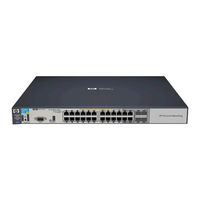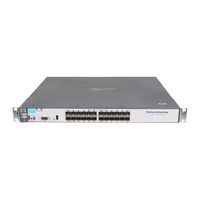HP ProCurve 6200yl-24G Manuals
Manuals and User Guides for HP ProCurve 6200yl-24G. We have 3 HP ProCurve 6200yl-24G manuals available for free PDF download: Advanced Traffic Management Manual, Access Security Manual, Product End-Of-Life Disassembly Instructions
HP ProCurve 6200yl-24G Advanced Traffic Management Manual (460 pages)
Switch Software
Table of Contents
-
-
Overview
23 -
Introduction
24 -
Terminology
26 -
-
-
Voice Vlans80
-
-
2 Gvrp
91-
Overview
91 -
Introduction
92
-
-
-
Overview
109 -
Configuring MSTP
123 -
Loop Protection
180 -
STP Loop Guard
186
-
-
4 Switch Meshing
193-
Introduction
193 -
-
Flooded Traffic209
-
Static Vlans213
-
Dynamic Vlans214
-
Jumbo Packets214
-
-
-
-
Qos Terminology
222 -
Qos Operation
224 -
-
-
-
-
-
Status Messages364
-
-
Overview
365 -
Introduction
366 -
Configuring Qinq
375
-
-
-
Introduction
397 -
Traffic Classes
398 -
Zone Classes
435 -
Index
447
-
Advertisement
HP ProCurve 6200yl-24G Access Security Manual (390 pages)
Table of Contents
-
-
Contents23
-
Introduction24
-
Conventions24
-
Keys26
-
Online Help29
-
-
Contents35
-
Overview36
-
Clear Button44
-
Reset Button45
-
-
Contents57
-
Introduction59
-
Terminology63
-
-
-
Contents89
-
Overview90
-
Terminology97
-
Overview105
-
Overview110
-
Client Status117
-
-
-
Contents119
-
Overview120
-
Before You Begin126
-
Operating Notes143
-
-
-
Overview147
-
Terminology148
-
-
Overview182
-
Terminology183
-
-
-
Overview210
-
Terminology211
-
With the CLI218
-
Interface221
-
-
-
Introduction232
-
Overview232
-
Filter Limits233
-
Protocol Filters246
-
Filter Indexing252
-
-
-
General Features257
-
Overview257
-
Accounting260
-
Introduction278
-
Port-Security295
-
Example296
-
Operating Notes311
-
-
-
Basic Operation316
-
Port Security316
-
MAC Lockout343
-
-
-
Overview358
-
Access Levels359
-
Operating Notes368
-
Overview372
-
Advertisement


